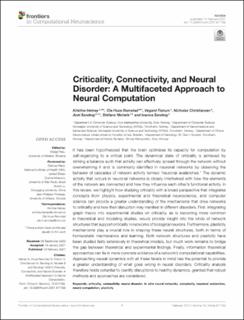| dc.contributor.author | Heiney, Kristine | |
| dc.contributor.author | Huse Ramstad, Ola | |
| dc.contributor.author | Fiskum, Vegard | |
| dc.contributor.author | Christiansen, Nicholas | |
| dc.contributor.author | Sandvig, Axel | |
| dc.contributor.author | Nichele, Stefano | |
| dc.contributor.author | Sandvig, Ioanna | |
| dc.date.accessioned | 2021-02-15T10:04:20Z | |
| dc.date.available | 2021-02-15T10:04:20Z | |
| dc.date.created | 2021-02-10T10:55:51Z | |
| dc.date.issued | 2021 | |
| dc.identifier.issn | 1662-5188 | |
| dc.identifier.uri | https://hdl.handle.net/11250/2728005 | |
| dc.description.abstract | It has been hypothesized that the brain optimizes its capacity for computation by self-organizing to a critical point. The dynamical state of criticality is achieved by striking a balance such that activity can effectively spread through the network without overwhelming it and is commonly identified in neuronal networks by observing the behavior of cascades of network activity termed “neuronal avalanches.” The dynamic activity that occurs in neuronal networks is closely intertwined with how the elements of the network are connected and how they influence each other’s functional activity. In this review, we highlight how studying criticality with a broad perspective that integrates concepts from physics, experimental and theoretical neuroscience, and computer science can provide a greater understanding of the mechanisms that drive networks to criticality and how their disruption may manifest in different disorders. First, integrating graph theory into experimental studies on criticality, as is becoming more common in theoretical and modeling studies, would provide insight into the kinds of network structures that support criticality in networks of biological neurons. Furthermore, plasticity mechanisms play a crucial role in shaping these neural structures, both in terms of homeostatic maintenance and learning. Both network structures and plasticity have been studied fairly extensively in theoretical models, but much work remains to bridge the gap between theoretical and experimental findings. Finally, information theoretical approaches can tie in more concrete evidence of a network’s computational capabilities. Approaching neural dynamics with all these facets in mind has the potential to provide a greater understanding of what goes wrong in neural disorders. Criticality analysis therefore holds potential to identify disruptions to healthy dynamics, granted that robust methods and approaches are considered. | en_US |
| dc.language.iso | eng | en_US |
| dc.publisher | Frontiers Media | en_US |
| dc.rights | Navngivelse 4.0 Internasjonal | * |
| dc.rights.uri | http://creativecommons.org/licenses/by/4.0/deed.no | * |
| dc.title | Criticality, Connectivity, and Neural Disorder: A Multifaceted Approach to Neural Computation | en_US |
| dc.type | Peer reviewed | en_US |
| dc.type | Journal article | en_US |
| dc.description.version | publishedVersion | en_US |
| dc.source.journal | Frontiers in Computational Neuroscience | en_US |
| dc.identifier.doi | https://doi.org/10.3389/fncom.2021.611183 | |
| dc.identifier.cristin | 1888402 | |
| dc.relation.project | Samarbeidsorganet mellom Helse Midt-Norge og NTNU: 46055600-151 | en_US |
| dc.relation.project | Norges forskningsråd: 270961 | en_US |
| dc.relation.project | Norges forskningsråd: 286558 | en_US |
| dc.relation.project | Samarbeidsorganet mellom Helse Midt-Norge og NTNU: 90368200 | en_US |
| dc.relation.project | ALS Norge: x | en_US |
| dc.relation.project | Samarbeidsorganet mellom Helse Midt-Norge og NTNU: 90501400 | en_US |
| dc.description.localcode | © 2021 Heiney, Huse Ramstad, Fiskum, Christiansen, Sandvig, Nichele and Sandvig. This is an open-access article distributed under the terms of the Creative Commons Attribution License (CC BY). The use, distribution or reproduction in other forums is permitted, provided the original author(s) and the copyright owner(s) are credited and that the original publication in this journal is cited, in accordance with accepted academic practice. No use, distribution or reproduction is permitted which does not comply with these terms. | en_US |
| cristin.ispublished | true | |
| cristin.fulltext | original | |
| cristin.qualitycode | 1 | |

